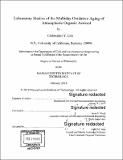Laboratory studies of the multiday oxidative aging of atmospheric organic aerosol
Author(s)
Lim, Christopher Y.(Christopher Yung-Ta)
Download1102669039-MIT.pdf (12.85Mb)
Other Contributors
Massachusetts Institute of Technology. Department of Civil and Environmental Engineering.
Advisor
Jesse H. Kroll.
Terms of use
Metadata
Show full item recordAbstract
Fine particulate matter (PM, or "aerosol") in the atmosphere affects the Earth's radiative balance and is one of the most important risk factors leading to premature mortality worldwide. Thus, understanding the processes that control the loading and chemical composition of PM in the atmosphere is key to understanding air quality and climate. However, the chemistry of organic aerosol (OA), which comprises a significant fraction of submicron atmospheric PM, is immensely complex due to the vast number of organic compounds in the atmosphere and their numerous reaction pathways. Laboratory experiments have generally focused on the initial formation of OA from volatile organic compounds (VOCs), but have neglected processes that can change the composition and loading of OA over longer timescales ("aging"). This thesis describes several laboratory studies that better constrain the effect of two important aging processes over timescales of several days, the oxidation of gas phase species to form secondary OA (condensation) and the reaction of gas phase radicals with organic molecules in the particle phase (heterogeneous oxidation). First, the oxidation of biomass burning emissions is studied by exposing particles and gases present in smoke to hydroxyl radicals (OH). Increases in organic aerosol mass are observed for all fuels burned, and the amount of OA formed is explained well by the extent of aging and the total concentration of measured organic gases. Second, the effect of particle morphology on the rate of heterogeneous oxidation is examined by comparing the oxidation of particles with thin organic coatings to the oxidation of pure organic particles. Results show that morphology can have a strong impact on oxidation kinetics and that particles with high organic surface area to volume ratios can be rapidly oxidized. Third, the molecular products from the heterogeneous OH oxidation of a single model compound (squalane) are measured. Formation of a range of gas-phase oxygenated VOCs is observed, indicating the importance of fragmentation reactions that decrease OA mass, and providing insight into heterogeneous reaction mechanisms. The results from this work emphasize that the concentration and composition of OA can change dramatically over multiple days of atmospheric oxidation.
Description
Thesis: Ph. D., Massachusetts Institute of Technology, Department of Civil and Environmental Engineering, 2019 Cataloged from PDF version of thesis. Includes bibliographical references.
Date issued
2019Department
Massachusetts Institute of Technology. Department of Civil and Environmental EngineeringPublisher
Massachusetts Institute of Technology
Keywords
Civil and Environmental Engineering.